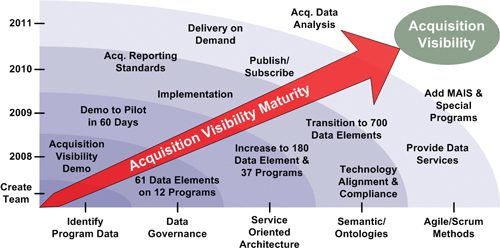Technical Perspective: AV leadership’s insistence to be “world class” in technical delivery is the nucleus for sharing acquisition information (Table 3). Acquisition Visibility is an information service that relies heavily on systems and software engineering and other technical best practices such as cloud computing and open source software to achieve its objectives. The use of technical best practices and services provides delivery teams flexibility when managing technical requirements, reduces Acquisition Visibility’s footprint and organizational impacts across DoD, and provides delivery teams access to cutting-edge tools to address unique, changing information demands. This information service is a federation of software and data of various servers across OSD and the Military Departments to promote internal cooperation among Components. Strong information stewardship ensures the best value regardless of where the servers are located. The use of both organic and private industry expertise with systems and software engineering, SOA and data governance enables Acquisition Visibility to provide leadership strong support despite the varying complexities of security, architecture and infrastructure. As the amount of information shared across the service continues to expand, DoD has looked to more automated and accurate ways to share acquisition data. Just last year, acquisition leadership worked with Components to implement a Department-wide “publish and subscribe” process. This process allows leadership to pull data from the various acquisition portfolios making data more readily available to leadership and promoting better data quality among the Components. As these types of techniques mature, Acquisition Visibility can continue to serve as a technical model that utilizes the most advanced technologies and best practices while reducing costs and the overall technical footprint.
Figure 2 below depicts Acquisition Visibility’s maturity and growth since its inception as a pilot program three years ago. Three perspectives measure Acquisition Visibility’s maturity. First is the functional growth and improvements to Acquisition Visibility (Y-axis). Second is the increase of acquisition information shared across DoD as acquisition leadership took a combination of organizational and technical steps to improve data delivery (X-axis). Third is a combination of both perspectives: DoD realizes capability synergies and achieves technical transformation.
Figure 2: Acquisition Visibility’s Maturity and Growth
Overcoming Challenges for an Information Acquisition Future
No technology, organization or process is a perfect solution and DoD’s work to implement Acquisition Visibility came with numerous challenges. While AV leadership deliberately used the strategic, functional and technical activities to mitigate anticipated issues, delivery teams continue to work the many common problems today. Data transparency has always been a primary obstacle to achieving Acquisition Visibility. Organizational tendencies to compartmentalize acquisition data – reflecting their authority to acquire and manage their own major programs – and a hesitancy to share critical acquisition information with outside organizations are being overcome. However, the clarity that Acquisition Visibility brings to identify authoritative sources of data, determine end-user requirements, and meet multiple data and information demands offers a bright future for DoD’s acquisition portfolio.



